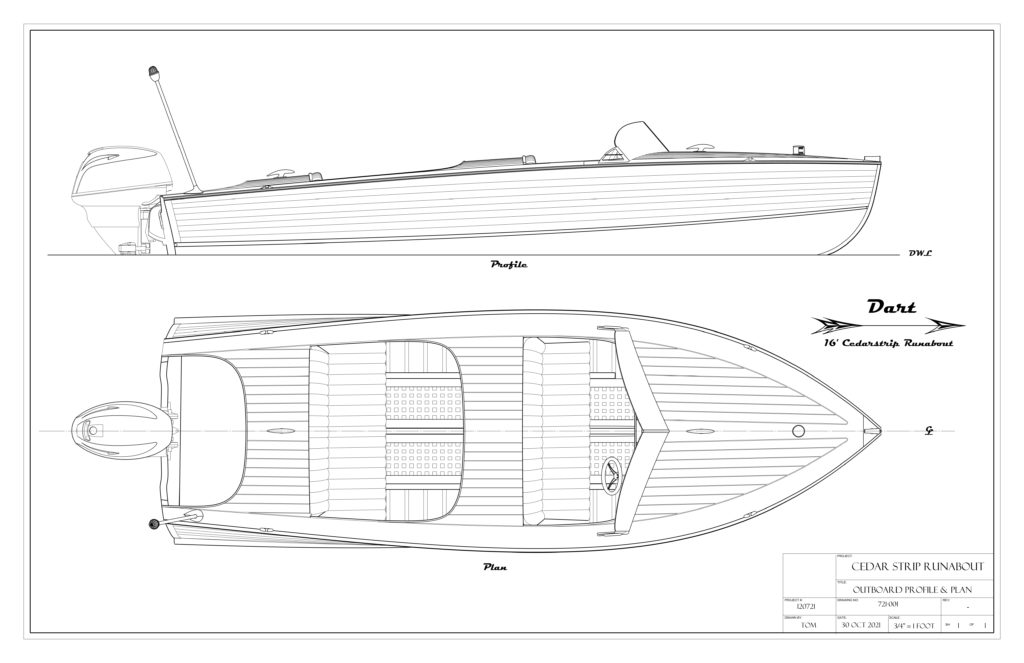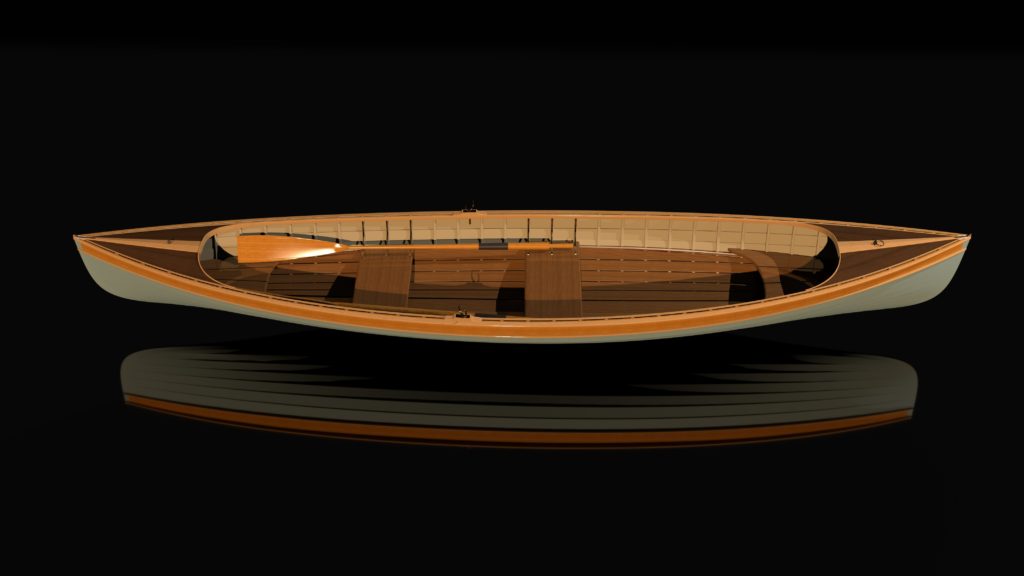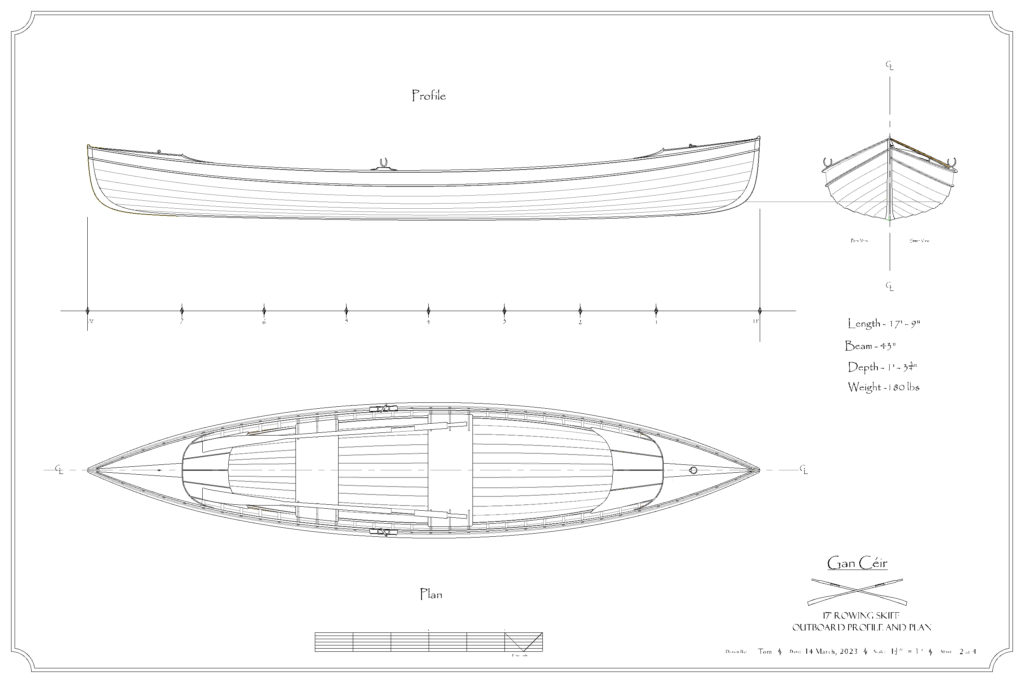Small Boat Designs for the Lake & Cottage

Dart - a Cedar Strip Outboard Runabout Design
Dart:
It started with a simple doodle – One of the first few doodles I made when I started classes in the Yacht Design Program at The Landing School in Arundel,
Maine


Dart is inspired by the small cedar strip runabouts that were very popular in years past – especially in the ’50s. This particular design evolved from one of the first assignments I had while in the Yacht Design Program at The Landing School. The assignment went no further than the original sketch. I decided to take it further when I found the sketch while cleaning up some boxes and notebooks at home.
Dart is the result – a 16′ runabout built in the classic cedarstrip style; thin & narrow cedar strip planks fastened to steam bent oak frames with copper clench nails . A deck of cedar planks with mahogany cover boards and king plank, all caulked with traditional yellow compound and some chrome plated hardware fittings give it a deluxe look. The outboard on the transom is a modern 25 hp – a motor which will make it go “fast enough”. I think I referred to the design in class as the “Mazda Miata” of boats – simple, sporty, and a lot of fun…
Length – 16′
Beam – 5′ 5″
Construction – Traditional cedar strip on close spaces steam bent oak frames.
Power – Outboard motor (25hp shown in drawings & renderings)
Salar - A 20' SeaSkiff Design

Salar is a 20′ Lapstrake inboard design influenced by Chris Craft Sea Skiffs and the Lyman Islanders, boats which have an enthusiastic ownership and following to this day. These boats were production built using the very best mass production skills and techniques of the time, with many parts being produced from patterns.
Salar allowed me to develop new skills in Rhino – some rendering skills, and more importantly, the ability to create lapstrake planking (its easier to do in real life!). My hope is to be proficient enough in creating lapped planks that they can be exported into a CNC system and real planks created. It may be asking a lot/too much – but it was fun.
The boat uses modern diesel power to get a top speed of 22 knots and an economical cruise of 15 knots; not watersports/towboat speeds – but good for comfortable day-cruising and seeing the sights while out on the water . I think Salar would make an excellent cottage runabout.
Length – 20′ 5″
Beam – 7′ 7″
Construction – Lapstrake ply on steam bent oak frames
Power – Diesel Inboard
Salar and Dart will be updated as I revisit and overthink them…
I am revisiting both Salar and Dart. This will include an outboard version for Salar, and more details for Dart, including a “Builders Bid Package”.
Gan Céir - A 17'9" Rowing Skiff Design
This rowing skiff has been bouncing around in my head for decades. It draws inspiration from a number of sources; from my father, who was a member of the rowing team at Cambridge University and had a life long love of rowing thereafter, from my first paying job as a boatbuilder doing restoration work on St. Lawrence River Skiffs, and from my work at The Tender Craft Boat Shop in the ’80s and ’90s and my own business after that
I left boatbuilding completely in 2002; life had other plans, and so the skiff never evolved beyond my thoughts.
More Inspiration;
A few years back, a friend commented on how animated I was while talking about boats – and rowboats in particular…
I said it was the coffee & fudge for breakfast….
It did get me thinking more seriously about boats – which led me The Landing School in Arundel, Maine, where I studied Marine Systems and Yacht Design for almost two years. It was time very well spent.
So Gan Céir is a bit of self indulgence – what I think a good rowing skiff should be. It is not symmetrical fore and aft, trimming a little by the stern when rowing from the midship thwart. Flipping direction allows use of the same rowlock sockets while accompanied by a passenger – or a week’s worth of provisions to that water access property/cabin.
Offsets and details will allow for a bit of latitude in size and construction method. I think it could be stretched a bit – to almost 19 feet, and alternate methods like glued-lap ply or wood-strip epoxy may be possible; though a lapstrake sheer would really set it off. Builder’s choice to make it “Their own”
Maybe that’s what the name was all about…
The lines were drawn to the inside of planking. Although drawn as a traditional lapstrake build, other possibilities exist – glued-lap ply, or event wood-strip epoxy ( I will post a rendering of such a possible build).
In the coming weeks I will post more info – a table of offsets for the boat as drawn, and some construction details as well.











